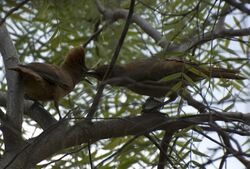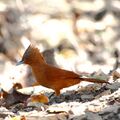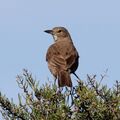Biology:Cacholote
| Cacholote | |
|---|---|

| |
| Brown cacholote (Pseudoseisura lophotes) | |
| Scientific classification | |
| Domain: | Eukaryota |
| Kingdom: | Animalia |
| Phylum: | Chordata |
| Class: | Aves |
| Order: | Passeriformes |
| Family: | Furnariidae |
| Genus: | Pseudoseisura Reichenbach, 1853 |
| Type species | |
| Anabates gutturalis White-throated cacholote D'Orbigny & Lafresnaye, 1838
| |
| Species | |
|
Pseudoseisura cristata | |
The cacholotes are four species of relatively large, heavy-billed furnariids in the genus Pseudoseisura. They are found in shrubby habitats in the South American countries of Brazil , Bolivia, Argentina , Paraguay and Uruguay. They are essentially brown (ranging from deep rufous to pale gray-brown depending on species), and all are crested to some extent.
Taxonomy
The genus Pseudoseisura was introduced in 1853 by the German naturalist Ludwig Reichenbach to accommodate the white-throated cacholote.[1][2] The name combines the Ancient Greek pseudos meaning "false" and seisoura, a bird mentioned by the Greek lexicologist Hesychius of Alexandria and believed to be a wagtail Motacilla.[3]
Species
The genus contains four species:[4]
- †Pseudoseisura cursor (Pleistocene of Argentina)[5]
The allopatric Caatinga and gray-crested cacholotes were formerly considered conspecific under the name rufous cacholote (Pseudoseisura cristata).[6]
References
- ↑ Reichenbach, Ludwig (1853). "Icones ad synopsin avium No. 10 Scansoriae A" (in German). Handbuch der speciellen Ornithologie. 6. Dresden und Leipzig: Expedition Vollständigsten Naturgeschichte. pp. 145–218 [146, 168]. https://www.biodiversitylibrary.org/page/47722870.
- ↑ Peters, James Lee, ed (1951). Check-List of Birds of the World. 7. Cambridge, Massachusetts: Museum of Comparative Zoology. p. 122. https://www.biodiversitylibrary.org/page/14480459.
- ↑ Jobling, James A. (2010). The Helm Dictionary of Scientific Bird Names. London: Christopher Helm. p. 321. ISBN 978-1-4081-2501-4.
- ↑ Gill, Frank; Donsker, David; Rasmussen, Pamela, eds (January 2021). "Ovenbirds, woodcreepers". IOC World Bird List Version 11.1. International Ornithologists' Union. https://www.worldbirdnames.org/bow/ovenbirds/. Retrieved 30 June 2021.
- ↑ Tonni, Eduardo P.; Norieg, Jorge I. (2001). "Una especie extinta de Pseudoseisura Reichenbach 1853 (Passeriformes: Furnariidae) del Pleistoceno de la Argentina: Comentarios Filogeneticos". Ornitologia Neotropical 12 (1): 29–44. https://sora.unm.edu/sites/default/files/journals/on/v012n01/p0029-p0044.pdf.
- ↑ Zimmer, Kevin J.; Whittaker, Andrew (2000). "The Rufous Cacholote (Furnariidae: pseudoseisura) is two species". The Condor 102 (2): 409–422. doi:10.1650/0010-5422(2000)102[0409:TRCFPI2.0.CO;2]. https://sora.unm.edu/sites/default/files/journals/condor/v102n02/p0409-p0422.pdf.
Wikidata ☰ Q1060802 entry
 |





